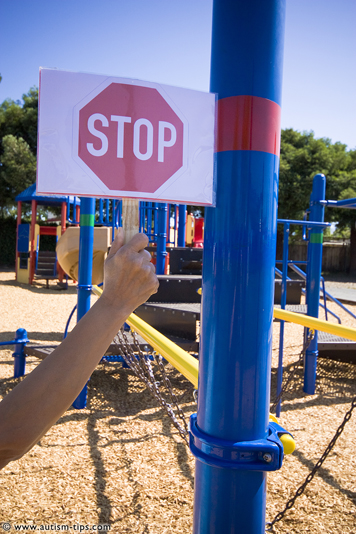Compliance Is Attainable
Nadia Shanab | autism, general advice, parenting, tips1 Aug 2015

People tend to perceive noncompliance as stubbornness or misbehavior. Autistic kids do not always perceive our directions the way neurotypical kids do. Why? Because of their sensory integration issues or their condition in general. They see, hear, smell, feel and process (think) differently. When the child doesn’t comply or conform, she/he is trying to communicate with his world, but can not quite express herself/himself in the typical way. His/her skills are not adequate to reach our mind. It is our (parents and educators) job to try to figure out (decipher) what the behavior is meant to tell. The following are three example on this matter.
The GO/STOP Technique
I had one student who wouldn’t respect the color coded signs on the play ground . There was red and green bands on the play structure to indicate a one way system to prevent the kids from bumping into each other. It didn’t matter to give him verbal prompts or even join him on the play structure to tell him that he is going the wrong way. What really worked well was much simpler than I have ever imagined. I made a green Go sign and red STOP sign as shown in the picture. I placed the signs next to the bands and didn’t do anything else. He was able to associate the meaning of the signs to the colored bands and got the concept of the one way system. I never had to use the signs again for this particular activity. It was a one time teaching/learning.
The Power of Pictures
Another autistic first grade child used to throw very frequent temper tantrums (almost everyday) and scream on the top of his lungs when he doesn’t get things his way. I exhausted all the means I know of to avoid and solve the problem by talking and directing his attention to different activity, in vain. Then I decided to use pictures. I got a picture of a crying baby, a screaming child who looked mad, and a daisy flower. I asked his mom to give me a picture of him. From the picture I’ve cut out the beautiful smiley face of the child and glued it on the center of the daisy flower. On a construction paper I glued the three pictures. I seized the opportunity when he was once in a good mood and showed him the pictures and said: “Do you cry like a baby?” He looked at me and laughed and said: “No!!!” He was beaming. Then I said: “Do you scream like crazy?” He laughed even more and said: “No!!!” Then I said: “Do you smile like a daisy?” He said: “Yes!!!” With a big smile on his face he took the paper and kept looking at it for a while with amazement. I think he was assessing his behavior in relation to the pictures. He really was able to connect the dots. Ever since, every time I feel the tantrums looming I take this paper out and leave it on the desk and he would change his attitude and become more cooperative. In this case the student responded to visual prompts rather than anything else. There was no more screaming no more tantrums.
The message to the child here was: “you can make good choices, you can change your behavior, you can look really nice when you are smiling”.
The Walk/STOP Technique
One student I worked with used to run away and would not respond to my verbal prompts when we walked together. I used to tell him:”Walk with me” or “Stay with me”. It never worked. I ended up holding his hand and practiced the Walk/Stop technique.
In the beginning I would walk a few steps and say STOP loudly and firmly. Then wait for a second or so to mark the STOP time, then walk again. I kept doing this but changed the number of steps (random number) every time to make sure that the response is to the prompt STOP and not to the count of the number of steps-because this particular student was a profound autistic boy and he had a lot of OCDs (obsessive compulsive disorders) including counting. We practiced the walk/stop technique for a couple of weeks consistently, for fifteen minutes first thing in the morning. Then I decided not to hold his hand anymore because we are working towards independence and safety. To my biggest surprise, the student acted as if I was holding his hand, and stayed next to me. He walked when I walked and stopped when I stopped without even saying stop. Note that practicing was walk/stop technique was part of his daily schedule.
In this case the student didn’t respond to verbal prompts but rather to physical prompts. By holding his hand and moving and stopping together, the touch was effective.
nadia shanab
More Tips
Tags: asperger's syndrome, autism, communication, compliance, defiant behavior, discipline, flexibility, ODD, parenting, schedule, social interaction, tips


